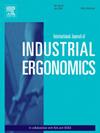Validating the recommended cumulative rest allowance equation for use in workload management
IF 3
2区 工程技术
Q2 ENGINEERING, INDUSTRIAL
International Journal of Industrial Ergonomics
Pub Date : 2025-04-18
DOI:10.1016/j.ergon.2025.103746
引用次数: 0
Abstract
The Recommended Cumulative Rest Allowance (RCRA) equation estimates rest requirements based on effort intensity and duty cycle and may be important when optimizing daily workload to maintain productivity without undue muscle fatigue development; however, its validity has not been confirmed. Thus, the purpose of this study was to investigate whether muscle fatigue accumulates when rest time is insufficient according to the RCRA equation, and whether no fatigue occurs in protocols deemed to have sufficient or excess rest. Thirty-two participants performed isometric triceps extensions under three protocols: insufficient rest, sufficient rest, and excess rest for the same total work. Muscle fatigue was assessed by comparing maximum voluntary exertions (MVE) before and after each protocol and investigating amplitude and frequency changes in surface electromyography recorded from the triceps. MVE significantly decreased by an average of 2.4 % after all protocols.
Participants showed significantly higher EMG amplitudes and lower mean power frequencies over time during the insufficient rest protocol, however, no changes were observed in the sufficient and excess rest protocols. This provides evidence supporting that the RCRA may be a useful tool to optimize workloads in the workplace; however, studies using longer exposure times are necessary to confirm its effectiveness.
验证在工作负载管理中使用的推荐的累积休息津贴公式
建议累积休息量(RCRA)公式根据工作强度和工作周期估计休息需求,在优化日常工作量以保持生产力而不过度肌肉疲劳发展时可能很重要;然而,其有效性尚未得到证实。因此,本研究的目的是研究根据RCRA方程,当休息时间不足时,肌肉疲劳是否会累积,以及在被认为是充分休息或过度休息的方案中是否不会发生疲劳。32名参与者在三种方案下进行了等长肱三头肌伸展运动:不充分休息、充分休息和在相同的总工作量下过度休息。通过比较每个方案前后的最大自主劳力(MVE),并调查三头肌表肌电图记录的幅度和频率变化来评估肌肉疲劳。在所有方案后,MVE平均显著降低2.4%。在不充分休息方案中,随着时间的推移,参与者表现出明显更高的肌电振幅和更低的平均功率频率,然而,在充分休息和过度休息方案中没有观察到变化。这提供了证据支持RCRA可能是优化工作场所工作量的有用工具;然而,需要使用更长的暴露时间进行研究来证实其有效性。
本文章由计算机程序翻译,如有差异,请以英文原文为准。
求助全文
约1分钟内获得全文
求助全文
来源期刊
CiteScore
6.40
自引率
12.90%
发文量
110
审稿时长
56 days
期刊介绍:
The journal publishes original contributions that add to our understanding of the role of humans in today systems and the interactions thereof with various system components. The journal typically covers the following areas: industrial and occupational ergonomics, design of systems, tools and equipment, human performance measurement and modeling, human productivity, humans in technologically complex systems, and safety. The focus of the articles includes basic theoretical advances, applications, case studies, new methodologies and procedures; and empirical studies.

 求助内容:
求助内容: 应助结果提醒方式:
应助结果提醒方式:


